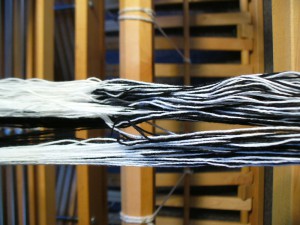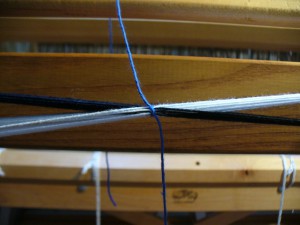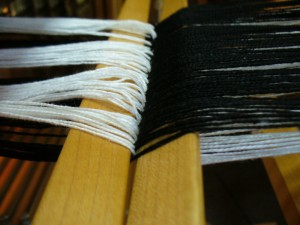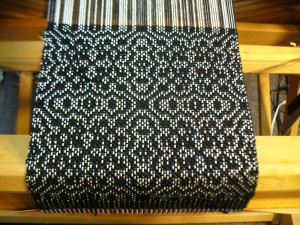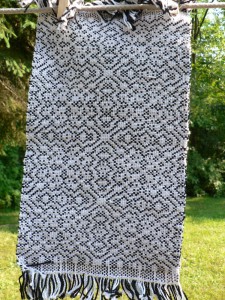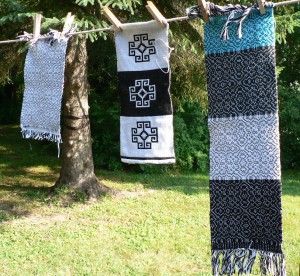July has been a very busy time, what with all the watering (it’s been hot and dry), squishing of bugs, and weeding, not to mention flax harvesting. However, I recently did a tiny bit of weaving for my double-weave study group with the Pioneer Valley Weavers Guild, led by the elegant and brilliant Barbara Elkins.
Doubleweave is a versatile technique that lets you weave two layers of cloth at the same time. The layers can be joined at the right or left edges, joined at both edges, they can be totally separate, or they can exchange periodically (i.e., the bottom layer comes to the top and the top layer goes to the bottom). Our samples used four shafts, which is the minimum number you need.
The whole process has been full of visual surprises, beginning with winding the warp. For our samples, we wound a warp with two alternating colors. I chose black and white for maximum contrast. On the left, below, is the cross with my counting thread. You can see the separation of the white and black layers. On the right is the warp as I was beaming on. The alternating black and white ends get sorted into their respective layers when they go through the lease sticks. In the section of the warp that hasn’t yet been beamed on there is a cool transition between where they alternate and where they become separated. I warp back to front, so this un-separated section is in the front of the loom.
Here is how the warp looked passing through the lease sticks (which maintain the cross, which keeps the threads in order). This is towards the back of the loom.
The first sample I did on this warp was Colonial doubleweave. This technique takes an overshot draft and translates it into a plain weave, doubleweave structure. Usually with overshot, weft floats (threads on the surface of the cloth that travel over more than one warp end) make the pattern, but they can get long and impractical. With traditional overshot, the cloth is stabilized with alternating rows or picks of plain weave (called tabby) to form the ground that holds the cloth together. In plain weave, the weft passes over one warp end, then under one, so it has no long floats.
With the doubleweave version of overshot, the pattern is made by the intersection of the bottom and top layers of the cloth. There are no long floats. The cloth is a little dense because it’s two layers woven together, but you sett it more loosely than you would for regular plain weave. I used 5/2 cotton for these samples.
Here is one of my overshot samples still on the loom. The warp isn’t striped, even though it looks that way. The stripes appear because some black warp ends from the bottom layer are raised to the surface with each row, or pick, of the pattern. In the last pick at the fell line (top of the cloth) you can see where I just wove these parts of the pattern. I like how it looks as if the warp threads are zooming into the cloth (well, they are in a sense). As soon as you change sheds, these stripes disappear, to be replaced by the next set of pattern threads.
This pattern is a name draft I developed from the phrase “we are made of dreams and bones” from The Garden Song by David Mallett.
Here’s a finished sample hanging up outside. Yes I have a couple weft skips. It’s hard to avoid when you can’t see the underside of your cloth. Depending on which color weft you use, and which side of the cloth you look at, you get different effects.
These are my doubleweave samples hanging on the line. The outer two are Colonial doubleweave. In the middle is the pick-up sample I did, which I will explain in the next post.

